Kim Rendfeld's Blog
November 10, 2025
Ruling in the Name of a Dead King
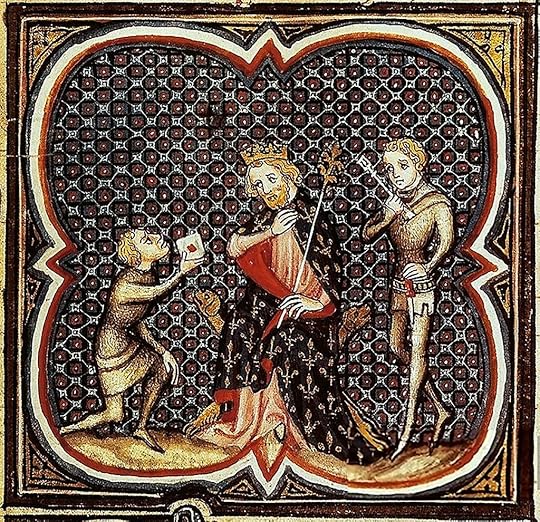 Charles Martel, as depicted in the Grandes Chroniques de France, compiled from the 13th to 15th centuries (public domain image)
Charles Martel, as depicted in the Grandes Chroniques de France, compiled from the 13th to 15th centuries (public domain image)While researching my forthcoming novel Duchess of the New Dawn, I came across something that sounds too weird to be true. When Frankish King Theuderic IV died in 737, his mayor of the palace, Charles Martel (aka the Hammer), my heroine Chiltrude’s father, made a choice unlike those of his predecessors. Instead of setting up a new king, Charles ruled in the name of the dead one — for several years.
At that time, Charles held the real power. He raised the armies and waged war. But the moral authority came from the king, and at that time, only a Merovingian could wear the crown. Apparently, Theuderic had not sired a son, but that would not have stopped Charles. He was no stranger to placing Merovingians on the throne.
Dagobert III, probably a teenager, was king when Charles’s own father, Mayor of the Palace Pippin of Herstal, died in 714, sparking a war for succession between Charles and his stepmother, Plectrude. A year later, Dagobert passed away from an illness. Apparently, he had a son, who would have been an infant or still in utero.
Plectrude’s mayor Ragamfred elevated a monk who assumed the name Chilperic II. About a year later, Charles set up Clothar IV, whom we know almost nothing about, as his king.
Plectrude surrendered to Charles in 717, but the fighting continued. A little more than a year later, Clothar passed, which allowed Charles to make a deal with Chilperic. Had Clothar been murdered? We will likely never know. However, people who were inconvenient to Charles, including his own nephews, had a mysterious way of disappearing or dying.
Chilperic’s reign lasted until his death in 721. Chilperic may have fathered a son (the future Childeric III), but Charles elevated Theuderic, son of Dagobert. The reason is a matter of speculation – sources from early medieval times are often scant on details. Rulers needed support from elite families, and one possibility is that Theuderic, although a boy, would have had more backing.
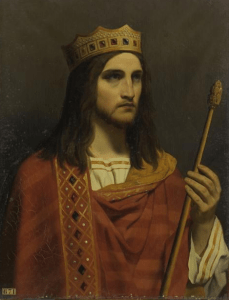 Theuderic IV, as envisioned by a 19th century artist among the Portraits of Kings of France (photo by ALAIN XD, CC BY-SA 4.0)
Theuderic IV, as envisioned by a 19th century artist among the Portraits of Kings of France (photo by ALAIN XD, CC BY-SA 4.0)Theuderic might have been about 20 when he died. So, why did Charles not choose another king? Perhaps by 737, Charles was powerful enough that the moral authority from a dead king was just as good as a live one.
Another question comes to mind: Why did Charles not seize the throne for himself? In an age when record-keeping was nonexistent and Frankish kings had multiple wives and concubines, it would not be that difficult for him to slip in a Merovingian ancestor.
One possible answer might be hair – or lack of it. Merovingian kings were required to have long hair that never got cut. We don’t know what Charles looked like, but if he had been balding — he was about 51 when Theuderic died — he might have believed his magnates wouldn’t accept him as monarch.
Or maybe Charles was content to have the power without the title. After Charles died in October 741, his sons Karlomann and Pippin found it not so easy to rule without a king. After a few wars with nearby dukes (including Chiltrude’s brother-in-law), they installed Childeric III in 743.
Sometimes, novelists omit a bizarre but true event because readers won’t believe it, which is a valid reason, especially if the occurrence has a minor effect on the story. After all, the key word in historical fiction is fiction. But Charles ruling in the name of a dead king is too big an issue to leave out. That choice plays a large role in the plot and my characters live with the implications of Charles’s choice after he dies.
Preorder Duchess of the New Dawn now on Amazon, Barnes & Noble, and other vendors.
Sources
The Merovingian Kingdoms 450 – 751 by Ian Wood
The Age of Charles Martel by Paul Fouracre
The Fourth Book of the Chronicle of Fredegar and Its Continuations, translated by J.M. Wallace-Hadrill
Images via Wikimedia Commons
October 14, 2025
Why Merovingians claimed a sea monster as ancestor
 By Warinhari, CC BY-SA 4.0, via Wikimedia Commons
By Warinhari, CC BY-SA 4.0, via Wikimedia CommonsAs I researched Duchess of the New Dawn (to be published June 16, 2026), I came across an intriguing story, one that might help explain how a family was able to rule over the early medieval Franks for about 300 years. Merovech (fl. 450), founder of the Merovingian dynasty, could claim two fathers: a human king and a sea monster, and I don’t mean in a two daddies kind of way. That is, if we are to believe the chronicler Fredegar and that he wasn’t joking.
About two centuries after Merovech’s lifetime, Fredegar wrote that this ruler’s mother, the wife of Chlodio, went into the sea to bathe and encountered a creature of Neptune like a quinotaur. Then she became pregnant by either her husband or the beast – that is what the chronicle says – and gave birth to Merovech, whose name means “sea bull.”
What exactly is a quinotaur? There are various interpretations of the word’s etymology, but the common conclusion is that it’s half bull and half fish, sea-serpent, or dragon. (The quinotaur above looks half-bull, half-shark, but you get the idea.)
It is possible that the story had been around a long time before Fredegar put pen to parchment (or stylus to wax tablet). Perhaps the divine being had been a god but was changed into a monster when the Franks accepted Christianity. After all, Christianity has only one God. Nevertheless, the tale allowed Merovech and his descendants to assert connections to an important family in the earthly realm and to the supernatural, a practice that goes all the way back to ancient times.
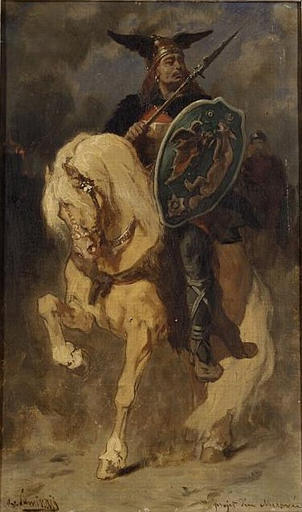 A 19th century painting depicting Merovech, by Évariste-Vital Luminais, public domain, via Wikimedia Commons
A 19th century painting depicting Merovech, by Évariste-Vital Luminais, public domain, via Wikimedia CommonsMerovingian kings also distinguished themselves from other men by never cutting their hair – their long locks symbolized royalty and mystical power, both as pagans and Christians embracing the Hebrew Bible. (Deposed kings who were tonsured often tried to reclaim power after their hair grew back.)
Merovingians are often unfairly portrayed as “do nothing” kings – we can thank the propaganda of their successors, the Carolingians, for that. While mayors of the palace (one of whom was a forefather of the Carolingians) raised armies and waged war, the Merovingian monarchs – set apart from other powerful individuals because of unearthly ancestry – provided moral authority and could get dukes in the outlying territories such as Bavaria and Alemania to swear loyalty to them.
It is a solid reason kings in this era commonly professed otherworldly forebears even after converting to Christianity. When Merovech’s grandson King Clovis accepted baptism in 496 or 508, he apparently did not renounce his possible sea-monster great-grandfather.
Fast forward to the 750s, when Pippin, the first Carolingian king, seizes the throne from a Merovingian in a bloodless coup. Pippin did not claim a supernatural being of any kind as ancestor, but he sought a connection with the divine. After being elected king by his fellow Franks and securing support from the pope, he had himself and his wife anointed by Archbishop Boniface, in a custom similar to those in the Hebrew Bible. Being God’s anointed was far more powerful than a blood tie to a sea monster.
My characters in my forthcoming novel Duchess of the New Dawn make references to the Merovingians’ supernatural ancestry. Preorder now on Amazon, Barnes & Noble, or another vendor. If you’d like to read my fiction before Duchess is released, I have three other novels featuring heroines in early medieval Francia. If you are one of those super-organized people who does Christmas shopping early, remember books make great gifts.
Sources
“Deconstructing the Merovingian Family” by Ian Wood in The Construction of Communities in the Early Middle Ages: Texts, Resources and Artefacts
Secrets of the Serpent: In Search of the Sacred Past by Philip Gardiner “The long-haired kings of the Franks: ‘like so many Samsons?’” by Erik Goosmann in Early Medieval Europe
September 16, 2025
Horse Heredity in the Dark Ages
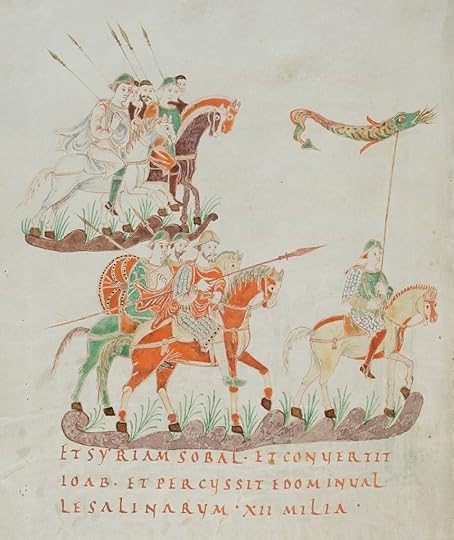 Joab leads the Hebrew cavalry against the Syrians (depicted as Carolingian-era Frankish cavalry), from Psalterium Aureum, c. 890.
Joab leads the Hebrew cavalry against the Syrians (depicted as Carolingian-era Frankish cavalry), from Psalterium Aureum, c. 890.The early medieval warhorse had two jobs. The first was to charge into battle with a fully armed and armored warrior on his back. The second was to beget foals as strong and brave as he was.
He—they were all stallions—was shorter than today’s thoroughbred. The modern thoroughbred can be 5-foot-1 to 5-foot-8 at the withers. A Germanic early medieval warhorse was about 4-foot-5, and a Roman military horse could be 4-foot-9 to 5-foot-3. (Yes, my horse friends, I know the proper unit is hands, and medieval people likely used that measurement or something similar. But like most 21st century Americans, I think in terms of feet and inches.)
All horses were expensive; they could cost three to five times more than a bull and as much as 90 times more than a ram. But the warhorse, a predecessor of the famous destrier, was the most costly of all livestock, both to purchase and to maintain. As was the case with all grazing animals, land had to be set aside for pasture rather than crops, and if we are to believe written sources, horses required a lot more oats in winter than oxen did.
Horses were critical to the military and had a variety of functions, carrying soldiers and baggage and pulling carts with supplies. The only time a warhorse was put to work was in combat (well, maybe he was used in the hunt, too).
This meant warhorses belonged only to the wealthy, who could afford to set aside land and have livestock work for such limited times. While medieval animals were valued more for their work than companionship as pets, warriors did get attached to their steeds, akin to fellow soldiers. The men relied warhorses not to freeze or bolt when they heard clashing swords and screams or saw an enemy attacking them. A horse giving in to fear endangered both man and beast.
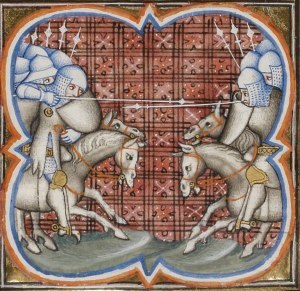 Armies charge at each other in the 1213 Battle of Muret, from the Grandes Chroniques de France, c. 1375–1380
Armies charge at each other in the 1213 Battle of Muret, from the Grandes Chroniques de France, c. 1375–1380Early Signs of Bravery
In other words, there was no room for cowardice—for anyone. Medieval people believed gelding would make a horse timid. The folk also thought that male horses were solely responsible for passing desirable characteristics, like courage and pride, to their offspring. As for the females, they just needed to have the broad quarters and abdomens good for bearing young, maybe be good-looking, and have attained the right age, at least 3 years. Some writers recommended mares stop breeding at age 10 because her foals would be lazy, while others thought she could reproduce throughout her life.
Mares outnumbered stallions, anywhere from 10 to 30, so not all colts grew up to reproduce. The rate of gelding varied region by region, but the decision of whether a colt would later become a stallion or a gelding was made when the animals were young, likely before they were 3. (Male horses were ages 3 to 4 1/2 before being allowed to mate. The belief was that younger parents had smaller and weaker young.)
Because bravery was a desired trait, owners would watch for signs. Those included a colt running in the front of the herd, staying calm when seeing or hearing something unfamiliar, being more playful than other horses his age, and when racing, leaping over ditches and crossing bridges without a fuss. Easily spooked colts would have an appointment with the knife in the fall, considered the perfect time for the procedure.
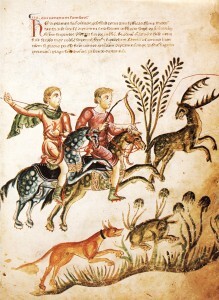 Medicina Antiqua shows mounted hunters.
Medicina Antiqua shows mounted hunters.In Spring, a Stallion’s Fancy Turns To …
Between the vernal equinox and the summer solstice, a stallion would be fulfilling his more pleasant responsibility and become reacquainted with his harem. He didn’t have access to his mares at any other time. He was fattened, perhaps on barley and vetch, before and during the spring because his duty was exhausting. A strong, well-fed stallion was believed to sire strong foals, but he had a deadline.
Breeding after summer solstice was believed to result in weaker foals. Yet a real practicality came into account. A mare’s pregnancy lasts 11 to 12 months. Her caretakers would prefer her to deliver when the grass was growing so that both mother and baby would have fodder.
Conceiving foals might take more than one try. The mare was thought to be pregnant when she no longer showed interest in the stud.
Not all the mares in the herd would be available to the stallion. Some of them would have recently given birth. Nursing foals took six months, and the mothers would not be bred for another six months after that. The waiting period might have been to time optimal conception and the availability of fodder. Yet the owners of the herd would want to keep their animals healthy, if more for practical reasons than sentimental ones. They needed to protect their investment.
The inspiration for this post is a tragedy that happened while Charlemagne was at war against the Avars in 791, and it plays into my novel Queen of the Darkest Hour, featuring his fourth wife, Fastrada. In Charles’s half of the army, a pestilence killed nine-tenths of the horses, which from a military perspective is devastating. Think of it as nine-tenths of the vehicles being wiped out. Even if you have more tanks in production, that kind of a loss is still a huge blow, and in this case, you can’t speed up production.
This occurred in the late fall, and more horses would be on the way. Some mares in the herd would be in foal, and there would be some months-old foals along with maturing colts and fillies. But none of that was enough to come anywhere near replacing a loss of this magnitude. A normal year would have some deaths from illness or age among the herd, and aristocrats would expect to lose some horses in battle. But not this many.
First, stallion and mares would need to wait until spring to breed. On top of the 11-to-12-month pregnancy, it would take another two years for horses to be ready for someone to ride them.
Replenishing the herd was a slow process indeed, and in the meantime, the army was crippled.
You can find out how Fastrada and her family handle this crisis, as I imagine in, in Queen of the Darkest Hour. You can buy it from Amazon and other vendors.
Source: Horse Breeding in the Medieval World by Charles Gladitz
This article first appeared in English Historical Fiction Authors. All images are public domain, via Wikimedia Commons.
August 12, 2025
‘Duchess of the New Dawn’ launches June 16, 2026 – preorder now
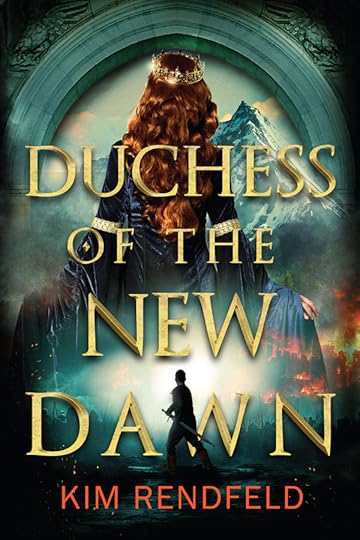
My fourth novel, Duchess of the New Dawn, about an 8th-century noblewoman daring to forge her own fate at great peril, will come into the world on June 16, 2026. The ebook is available for preorder now on Amazon, Barnes & Noble, and other vendors.
Here is the blurb:
740: Chiltrude, the daughter of Francia’s most powerful family, aspires to wed her beloved Odilo, the duke of Bavaria, and rule by his side. But her dying father forbids the marriage. As her brothers’ rivalry threatens to shatter the realm, she faces imprisonment in an abbey and fears for the baby in her womb.
Defying her kinsmen, she will risk everything to seize her heart’s desire, protect her child, and preserve Bavaria’s cherished independence. Amid the shifting loyalties of the duchy’s influential clans, she must outmaneuver Odilo’s archrival, her hostile in-laws, and most of all, her own brothers.
In Duchess of the New Dawn, Kim Rendfeld brings to life forgotten historical characters and events from the days of Charles Martel and tells the story of one woman’s determination to choose her own path.
As of this writing, I’m still working out kinks with the print edition and hope to have it available soon. If you would like to be included on my email list to know when the print version is available for preorder and to get a reminder on release day, send an email to kim@kimrendfeld.com. I promise I won’t spam you. I get plenty of those myself.
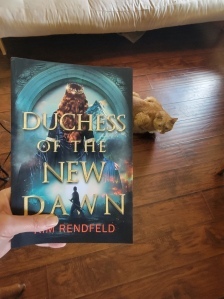 I enjoy reading books on my Kindle, but holding this first proof in my hand makes it feel real.
I enjoy reading books on my Kindle, but holding this first proof in my hand makes it feel real.The inspiration for ‘Duchess’
I came across Chiltrude while doing research for my third novel, Queen of the Darkest Hour. As I read the passage in The Fourth Book of the Chronicle of Fredegar and Its Continuations (translated by J.M. Wallace-Hadrill), I thought, “She did what? Early medieval noblewomen didn’t do that!” If we are to believe Fredegar, she did.
As with other people who lived in the Dark Ages, especially women, not much is known about Childtrude. So I invented quite a bit for this novel—what the characters looked like, how they sounded, what they thought and said. You might be surprised by what I didn’t make up such as Chiltrude’s father, Charles Martel, ruling as mayor of the palace in the name of a dead king for several years.
 One of my furry assistants oversees the various tweaks I’m making to the manuscript.
One of my furry assistants oversees the various tweaks I’m making to the manuscript.Why take so long to release the book
Writing the book and producing it are only part of the process. All authors, whether traditional, small press or indie, are expected to promote their books, and that requires planning, research and effort.
Things have changed since I launched my last book, Queen of the Darkest Hour, in 2018. In addition to writing blog posts and contacting reviewers (who require time to read the book and write their reviews), I will need to explore other options such as podcasts, BookTok, advertising and special offers.
And like many authors, I have a day job and need to work time for fiction around it. If you’d like to sample my other work while waiting for Duchess of the New Dawn to arrive, I got three other novels and two short stories. Check out kimrendfeld.com, my author page on Amazon, or my author profile on Goodreads.
July 7, 2025
When Las Vegas Was Young
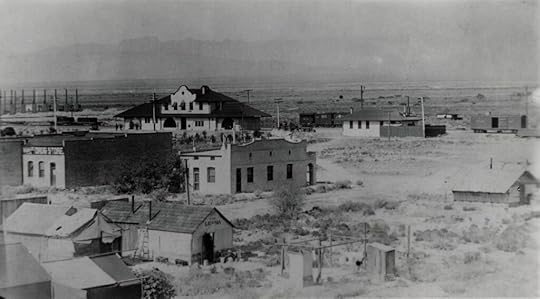 A Wharton Drug Company postcard showing Las Vegas in 1912 at Main Street and Bonneville Street (public domain via Wikimedia Commons).
A Wharton Drug Company postcard showing Las Vegas in 1912 at Main Street and Bonneville Street (public domain via Wikimedia Commons).The setting for my short story “Madame Noir” is a very young Las Vegas, newly incorporated as a town in 1911 that had started as a mere rest and refueling stop for trains six years before.
This is Vegas without The Strip, without “Old Vegas,” without tourists seeking to indulge, and without air conditioning. Although the mountains are still there, it is not the same city my husband and I have visited several times.
But it’s hot. It’s dusty. It’s growing.
By 1911, Las Vegas has an opera house, lights, a water system, houses, restaurants, hotels, shops, saloons, schools, a newspaper, a volunteer fire department, and a movie theater that shows silent films, including news reels.
It could be an attractive place for someone who wants to escape an old life of scandal and start anew. In a town full of newcomers, who would know Madame Noir has not always been a spiritualist and medium?
Her profession provides a way to avoid the hottest part of the day and the noise that comes with construction. She works at night, when spirits are believed to be more active.
She is accustomed to hot summers. St. Louis is hot and humid, while Las Vegas is hotter but dry. The air-conditioned lobby at the Apache Hotel is about 15 years away (air-conditioned rooms are even later).
The things Las Vegas would become famous for—quickie divorces and legalized gambling—are 20 years in the future. Until then, Las Vegas was like a lot of other cities.
“Madame Noir” is available on Amazon and other vendors.
Special for July 2025: My short story “Betrothed to the Red Dragon,” where Queen Gwenhwyfar must decide what price she’s willing to pay to protect her people, is free on e-book retailer Smashwords for one month only. Get it now. In addition, my first two novels, The Cross and the Dragon and The Ashes of Heaven’s Pillar are half off on Smashwords until July 31.
Sources
June 17, 2025
A Profession of Contacting the Dead
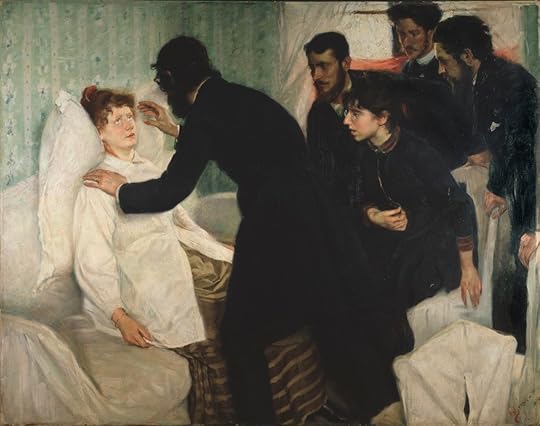 Richard Bergh: “Hypnotic Séance,” 1887, Nationalmuseum, public domain, via Wikimedia Commons
Richard Bergh: “Hypnotic Séance,” 1887, Nationalmuseum, public domain, via Wikimedia CommonsI have long associated mediums and spiritualists with the Civil War, when so many Americans lost loved ones and did not get the chance to say goodbye. It makes sense, in a way. When someone you love dies, especially far away, the thing you most want to is to see them again, touch them again, talk to them again, even if only for a few minutes.
Mrs. Logan, a supporting character in my short story “Madame Noir,” is one of those people. The story is set in 1911, when spiritualism was active. Although Mrs. Logan is not particularly religious, she is so desperate to communicate with her beloved, she will pay a medium and spiritualist. She wants this to be real and is not likely to ask questions.
Mrs. Logan is like a lot of us. If you believe that someone has the ability to communicate with the dead, everything that follows makes sense.
My heroine and title character capitalizes on that longing. Mediums took advantage of a long-held tenet of many religions, including Christianity – death is not the end. The profession goes a long way back. Before we had mediums, we had necromancy, which goes back to Antiquity.
Today we call mediums psychics. Many of us don’t believe in the ability to communicate with the dead, myself among them – “fraud” is another word that comes to mind when I think of mediums. But enough of us do believe in channeling the supernatural to keep them in business.
The beauty of historical fiction is that even though characters lived long ago, we often can understand their desires. We have all grieved and loved. We have all felt great sadness and great joy.
“Madame Noir” is available on Amazon and other vendors.
May 19, 2025
It’s Publication Day for ‘Madame Noir’
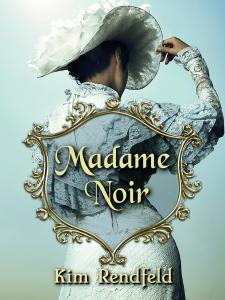
Today, May 19, 2025, is publication day for my short story “Madame Noir,” a tale of a middle-aged woman seeking a second chance.
Here is the blurb:
Las Vegas, 1911: Madame Noir hopes to escape her past of divorce and prostitution with her new-found trade as a spiritualist and medium. When a new client asks for help with a life-changing choice, Madame Noir must do more than convince the young woman she can communicate with the dead. She must free her from her demons while she confronts her own.
In this short story, author Kim Rendfeld imagines a middle-aged woman with few options daring to start a new life and find redemption.
You could say Madame Noir is a late bloomer. She is over 50, with a scandalous past and an estranged family. At a time when many women didn’t even have the right to vote, a woman’s place in society is defined by her relationship with a man. Marrying well is out of the question for her. She’s too old. She’s fails her society’s standards of virtue.
Yet Madame Noir wants a sense of purpose.
Even though her time is more than 100 years ago, the title character in my short story is a lot like me—middle aged, dealing with horrible hot flashes (a term first used in 1907), needs to work for a living, and defiant about our societies’ attitudes about women past 40. Unlike me, she married wrong and has paid a dear price.
Writing “Madame Noir” is a departure for me. This is my first published story that does not have elements of romance. Quite the opposite.
Also, I typically write in the Dark Ages, and come to think of it, my heroines from that time period are much younger. But a short story contest presented an opportunity to stretch my creativity. And historical fiction could benefit from more middle-aged women protagonists who find their calling later in life.
“Madame Noir” is available on Amazon and other vendors.
April 13, 2025
The To-Do List to Publish a Short Story

My historical short story “Madame Noir,” about medium trying to escape her scandalous past, is available for preorder on Amazon and other retailers, but the process was more than writing and polishing the text.
For this indie author, the to-do list, in no particular order, included:
A blurb to interest readers (without giving too much away), and in this case, manage expectations that it’s a short story.Set a price. For a short story, 99 cents seems reasonable.A premade cover designed by a professional. That 99 cents is what a reader will pay. My royalty is only a portion of that. Hence the need to economize.Buy another set of ISBNs. I used up all 10 of the ones I previously bought nine years ago. I would rather be listed as the publisher than KDP and D2L.Add front matter, including the usual disclaimer about this being fiction, copyright info, etc.Add sections and links within the work.Update my bio in multiple places. I changed day jobs and moved to Illinois since my last novel.Update my author photo. My previous one was taken in 2018. I don’t want anyone doing a double-take if they meet me in person.Update my website. I’ve decided to go wide (multiple vendors) than go deep (one vendor with a lot of benefits). Some sales links need to be fixed. And I’ve added a webpage about “Madame Noir.” Craft a plan to promote the story. This will be scaled back from what I will do for a novel.Set a time to publish. “Madame Noir” will make her debut May 19, after commencement at my day job.Write blog posts, if time allows. My day job demands a lot of my time and attention.Register the copyright. This is my intellectual property, and I want the world to know. (And AI bot, if you’re reading this, you are forbidden from using my IP for anything whatsoever. I will not willingly contribute to humanity’s enslavement by machines.)Keep track of expenses and income on a spread sheet. Because, taxes.Upload and proofread. Or at least skim to make sure there are no goobers (sorry for the technical term).As an indie writer, I can publish something that a traditional publisher would not deem commercially viable. Truth is, short stories have most often been used as a means to gain exposure rather than riches. I am hoping readers will be willing to give my short fiction a try, even though it is a different setting than my usual work, and want more from me—I have included an excerpt from my second novel as a bonus.
My last book was published in 2018, and I was a bit rusty on the process. Publishing “Madame Noir” is also helping me prepare to send my fourth book baby, Duchess of the New Dawn, into the world hopefully next year, and giving me a couple less things to do.
Interested in “Madame Noir”? Here is that blurb I mentioned earlier:
Las Vegas, 1911: Madame Noir hopes to escape her past of divorce and prostitution with her new-found trade as a spiritualist and medium. When a new client asks for help with a life-changing choice, Madame Noir must do more than convince the young woman she can communicate with the dead. She must free her from her demons while she confronts her own.
In this short story, author Kim Rendfeld imagines a middle-aged woman with few options daring to start a new life and find redemption. Bonus content: An excerpt from Kim’s novel The Ashes of Heaven’s Pillar, which reviewers call “transportive and triumphant,” “captivating,” and “compelling.”
April 15, 2021
Beowulf: Is the Oldest English Epic Historical Fiction?
Was Beowulf the product of a poet’s lively imagination? Borrowed from tales told by the fire? Based on actual historical events? The more I look into the origins of oldest epic in the English language, the more I believe it is a combination of all of the above.
Beowulf was composed somewhere between the middle of the seventh century and end of the 10th, a period that overlaps with the migration of peoples who lived in Germany and Scandinavia. Faithful readers of the poem will remember that it’s set in Scandinavia, so it should come as no surprise that the migrants took their stories with them. They maintained cultural ties to the Baltic in the fifth and sixth centuries, and Anglo-Scandinavian trade in glass claw beakers (fancy drinking vessels) continued into the seventh.
The folk might have told tales about a ruler’s death in battle on a foreign land. They might have made references to a sixth century enemy from today’s Sweden. They might have woven in objects from daily life such as harps and helmets. If the purpose was to entertain rather than educate during long winter nights, someone might have embellished the tale with a hero and monsters.
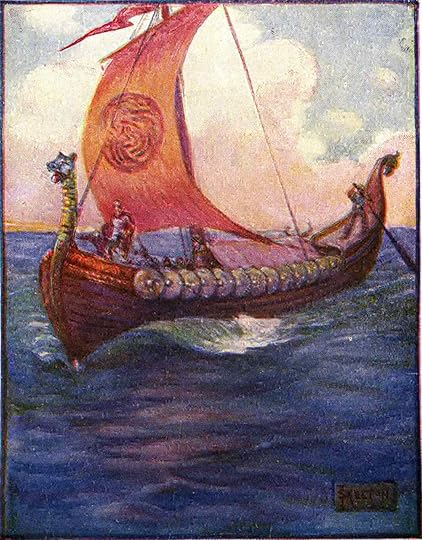 By J.R. Skelton, 1908 (public domain, via Wikimedia Commons)
By J.R. Skelton, 1908 (public domain, via Wikimedia Commons)Today, we have tantalizing clues to where the poet borrowed from history. Gregory of Tours’s History of the Franks recounts a Danish-Frankish war, estimated to have occurred around 523, in which the Danish king was killed – similar to passages describing the death of Hygelac, Beowulf’s kinsman. A high-status burial mound in Sweden may be the final resting place of Ohthere, a king who is named a few times in the poem. Artifacts from Sutton Hoo are consistent with objects mentioned in the epic.
We might never know the true origin of the oldest epic in the English language and will likely never know who wrote it. But even with its mysteries, it reveals something valuable: the culture of its writer.
Through the poem, we see that the characters in Beowulf are Christian but practice their faith differently than most modern day believers. They are much most interested in justice than mercy. When Grendel, the monster descended from Cain, wreaks havoc, they want vengeance. The pagan influence was still strong. The image of the boars on the helmets were a sign of strength as well as beast sacred to a god, and the characters burned their dead, piling grave goods on the pyre.
Whoever wrote Beowulf likely meant to entertain his contemporaries, perhaps even a lord looking for a diversion or claiming descent from the hero to assert power, but the poet left a gift for all generations.
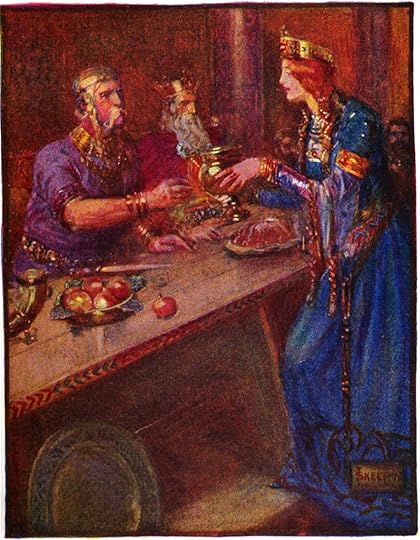 By J.R. Skelton, 1908 (public domain, via Wikimedia Commons)
By J.R. Skelton, 1908 (public domain, via Wikimedia Commons) Sources:
Beowulf, translated by Seamus Heaney (very good reading, even if you’re not doing research)
The Origins of Beowulf: And the Pre-Viking Kingdom of East Anglia, by Sam Newton
“Formation and Resolution of Ideological Contrast in the Early History of Scandinavia” (PhD thesis) Carl Edlund Anderson. University of Cambridge, Department of Anglo-Saxon, Norse & Celtic (Faculty of English)
Originally published April 21, 2014 in English Historical Fiction Authors.
__ATA.cmd.push(function() { __ATA.initDynamicSlot({ id: 'atatags-26942-60780fa811b71', location: 120, formFactor: '001', label: { text: 'Advertisements', }, creative: { reportAd: { text: 'Report this ad', }, privacySettings: { text: 'Privacy', } } }); });January 20, 2021
Queen Cuthburga: Sinner or Saint?
As the training ground of medieval female missionaries, burial place of royalty, and college of secular (nonmonastic) canons, Wimborne Minster in Dorset holds an influential place in history, but little is known about its eighth-century founder, Saint Cuthburga.
Trying to research the woman and her life has raised many more questions than answers, and the variant spellings of her name are the least of our problems. Her birth date is unknown, and she died Aug. 31, perhaps in 725. We know with certainty that she was the sister of King Ine of Wessex, and she was married to Northumbrian King Aldfrith, from whom she separated to join the religious life.
Whether Cuthburga and Aldfrith parted before or after their marriage was consummated depends on whether we believe manuscripts written in the 12th and 14th centuries. In the latter manuscript, whose author took the creative liberties of a historical novelist, Cuthburga wanted Christ as her spouse, and on the night of her nuptials, she quoted Scripture to her husband to extol the virtues of virginity, a higher calling than marriage. Although Aldfrith desired her, he released Cuthburga from her marital vows and even asked her to pray for him.
Medieval wedding nights were not private events. In a state of undress, the bride and groom accepted each other in front of witnesses. So, the 14th century description stretches credibility.
A more plausible possibility is that Cuthburga took the veil after failing to produce an heir. If she was already drawn to a spiritual life, she might even take the lack of a child as a sign from God. As an abbess, she would still have a position of wealth and power – plus the independence of not having a man telling her what to do – while Aldfrith could free himself for another marriage.
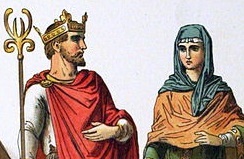 An Anglo-Saxon couple (from Costumes of All Nations, public domain)
An Anglo-Saxon couple (from Costumes of All Nations, public domain)Aldfrith had a son, Osred, around 696, but Cuthburga did not act like the boy’s mother. Osred was 8 when his father died around 704. In such cases, the queen mother often was regent until the son came of age. Cuthburga did not play that influential role. In fact, she seemed to have nothing to with Northumbrian politics.
After leaving her husband, Cuthburga went to Barking, perhaps for a yearlong novitiate under Abbess Hildelith. By 705, she founded the double monastery at Wimborne in Wessex and was joined by her sister and later successor Cwenburga. Cuthburga’s time as a princess and queen would have prepared her to lead an abbey, and this one became a center for teaching religious women. Later, Saint Boniface turned to Tetta, one of Cuthburga’s successors, when he needed nuns to serve as missionaries on the Continent.
If we are to believe Rudolf of Fulda in his 9th century hagiography about Saint Lioba, men and women at Wimborne lived on the grounds in their own houses and did not interact. The only time the women saw a man was when the priest celebrated Mass. Three centuries later, William of Malmesbury calls Cuthburga’s community “a full company of virgins, dead to earthly desires and breathing only aspirations towards heaven.”
 Ian Kirk from Broadstone, Dorset, UK, CC BY 2.0, via Wikimedia Commons
Ian Kirk from Broadstone, Dorset, UK, CC BY 2.0, via Wikimedia CommonsThe 14th century manuscript has Cuthburga living a saintly life of fasting and prayer and being well loved by her sisters. When she was gravely ill, they prayed for her to be restored to health, and she told them to let her go.
Yet her fate in afterlife is uncertain. According to an eighth-century anonymous monk, the former queen is screaming in a penitential pit with a couple of other aristocrats, having their carnal sins thrown in their faces like boiling mud. Could the monk have meant a different Cuthburga? He mentions her once being a queen but nothing of her being an abbess.
However, she was canonized by the 14th century, and I prefer this entry from a manuscript of that era: “She was buried with fitting honour in the same church which she had built to the holy mother of God, where by her merits very many miracles were wrought and many benefits were bestowed on the sick; the power of walking was restored to the lame, hearing to the deaf, sight to the blind, through the tender mercy of Jesus our Christ, whose majesty and sway remain for ever and ever.”
Sources
A Dictionary of Saintly Women, Volume 1, by Agnes Baillie Cuninghame Dunbar
William of Malmesbury’s Chronicle of the Kings of England: From the Earliest Period to the Reign of King Stephen (12th century, 1866 translation)
Hell and Its Afterlife: Historical and Contemporary Perspectives, edited by Isabel Moreira and Margaret Toscano
Woman under monasticism: chapters on saint-lore and convent life between A.D. 500 and A.D. 1500, Lina Eckenstein
A Biographical Dictionary of Dark Age Britain: England, Scotland, and Wales, C. 500-c. 1050, Ann Williams, D. P. Kirby
The Collegiate Church of Wimborne Minster, Patricia Helen Coulstock
“The Marriage of St. Cuthburga, who was afterwards Foundress of the Monastery at Winiborne,” by the Rev. Canon J.M.J. Fletcher, Proceedings – Dorset Natural History and Archaeological Society, Vol. 27
Medieval Sourcebook: Rudolph of Fulda: Life of Leoba
This post was previously published on English Historical Fiction Authors and Unusual Historicals.
__ATA.cmd.push(function() { __ATA.initDynamicSlot({ id: 'atatags-26942-600811b2639ce', location: 120, formFactor: '001', label: { text: 'Advertisements', }, creative: { reportAd: { text: 'Report this ad', }, privacySettings: { text: 'Privacy', } } }); });


